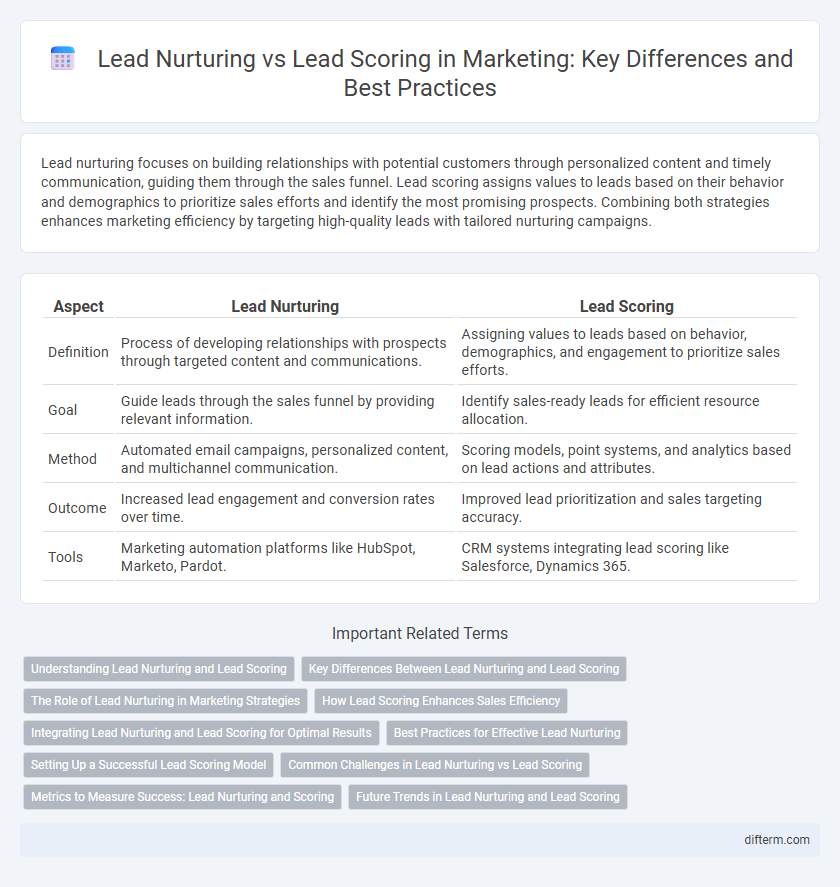Lead nurturing focuses on building relationships with potential customers through personalized content and timely communication, guiding them through the sales funnel. Lead scoring assigns values to leads based on their behavior and demographics to prioritize sales efforts and identify the most promising prospects. Combining both strategies enhances marketing efficiency by targeting high-quality leads with tailored nurturing campaigns.
Table of Comparison
| Aspect | Lead Nurturing | Lead Scoring |
|---|---|---|
| Definition | Process of developing relationships with prospects through targeted content and communications. | Assigning values to leads based on behavior, demographics, and engagement to prioritize sales efforts. |
| Goal | Guide leads through the sales funnel by providing relevant information. | Identify sales-ready leads for efficient resource allocation. |
| Method | Automated email campaigns, personalized content, and multichannel communication. | Scoring models, point systems, and analytics based on lead actions and attributes. |
| Outcome | Increased lead engagement and conversion rates over time. | Improved lead prioritization and sales targeting accuracy. |
| Tools | Marketing automation platforms like HubSpot, Marketo, Pardot. | CRM systems integrating lead scoring like Salesforce, Dynamics 365. |
Understanding Lead Nurturing and Lead Scoring
Lead nurturing involves developing relationships with potential customers through targeted content and communication to guide them through the sales funnel, enhancing engagement and trust. Lead scoring assigns numerical values to leads based on their behavior and demographic data, enabling marketers to prioritize prospects most likely to convert. Both strategies are essential for optimizing marketing efforts by aligning outreach with the prospect's readiness to purchase.
Key Differences Between Lead Nurturing and Lead Scoring
Lead nurturing involves engaging and building relationships with potential customers through personalized content and communication to guide them through the buyer's journey, while lead scoring assigns values to leads based on their behavior and demographics to prioritize sales efforts. Lead nurturing focuses on education and trust-building over time, whereas lead scoring emphasizes quantifying lead quality to identify sales-ready prospects. Both strategies are essential in marketing automation but target different stages of the sales funnel.
The Role of Lead Nurturing in Marketing Strategies
Lead nurturing plays a crucial role in marketing strategies by building relationships with potential customers through personalized content and targeted communication. It guides prospects through the sales funnel, increasing engagement and improving conversion rates by addressing their specific needs and pain points. Effective lead nurturing complements lead scoring by identifying the most promising leads and ensuring continued interaction until they are ready to make a purchase decision.
How Lead Scoring Enhances Sales Efficiency
Lead scoring enhances sales efficiency by systematically ranking prospects based on their engagement level and purchase readiness, enabling sales teams to prioritize high-potential leads and allocate resources effectively. By integrating behavior tracking, demographic data, and interaction history, lead scoring models provide actionable insights that shorten sales cycles and improve conversion rates. This targeted approach reduces time spent on unqualified leads, optimizing the overall sales pipeline performance.
Integrating Lead Nurturing and Lead Scoring for Optimal Results
Integrating lead nurturing and lead scoring enhances marketing efficiency by delivering personalized content based on prospect engagement levels and readiness to buy. Lead nurturing builds relationships through targeted communication, while lead scoring quantifies prospect quality using behavioral and demographic data to prioritize sales efforts. Combining these strategies ensures timely, relevant outreach that increases conversion rates and optimizes sales funnel management.
Best Practices for Effective Lead Nurturing
Effective lead nurturing involves delivering personalized content that addresses specific buyer needs at each stage of the sales funnel, using automated workflows to maintain consistent engagement. Best practices include segmenting leads based on behavior and demographics, leveraging multi-channel communication such as email, social media, and targeted ads, and regularly analyzing engagement metrics to refine nurturing strategies. Combining these techniques enhances lead qualification and accelerates the conversion process by building trust and staying top-of-mind with prospects.
Setting Up a Successful Lead Scoring Model
Setting up a successful lead scoring model involves assigning values to leads based on their behaviors, demographics, and engagement levels to prioritize sales efforts effectively. Integrating data from multiple touchpoints such as email interactions, website visits, and social media engagement refines score accuracy and improves conversion rates. Continuous analysis and adjustment of scoring criteria ensure the model aligns with evolving customer journeys and maximizes marketing ROI.
Common Challenges in Lead Nurturing vs Lead Scoring
Lead nurturing often struggles with personalized content delivery at scale, leading to decreased engagement and missed conversion opportunities. Lead scoring faces challenges in accurately assigning values due to inconsistent data and evolving buyer behaviors, which can result in misprioritized leads. Both processes require continuous data refinement and alignment between sales and marketing teams to optimize effectiveness and improve lead quality.
Metrics to Measure Success: Lead Nurturing and Scoring
Lead nurturing success is measured by metrics such as engagement rates, email open and click-through rates, and the progression of leads through the sales funnel. Lead scoring effectiveness relies on tracking lead qualification scores, conversion rates, and the speed at which leads move to closed deals. Both strategies require monitoring pipeline velocity and return on investment (ROI) to optimize marketing efforts and sales alignment.
Future Trends in Lead Nurturing and Lead Scoring
Future trends in lead nurturing emphasize personalized, AI-driven content delivery that adapts to individual buyer journeys, enhancing engagement and conversion rates. Lead scoring techniques are evolving to incorporate predictive analytics and machine learning models, enabling more accurate identification of high-potential leads based on real-time behavior and demographic data. Integration of these advanced technologies will streamline marketing efforts, improve lead quality, and accelerate sales cycles in increasingly competitive markets.
Lead nurturing vs lead scoring Infographic

 difterm.com
difterm.com